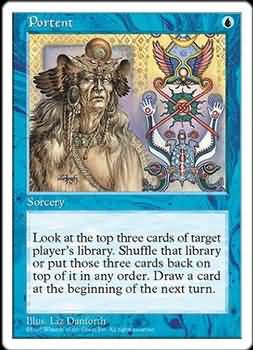Portent
(Divination)

Portent
(Divination)

|
|
|
|
|
|
|
|
|
|
|
|
|
|
|
|
|
|
Effect: This spell enables the cleric to tell something of his or another figure's "luck".
This "luck" takes the form
of an improvement or reduction in a "to hit" roll or a save at some point
in the future unknown to the character who is the object of the portent.
After the spell is cast,
the DM makes two die rolls in secret:
First, 1d12, to determine
at what point in the future the portent takes effect;
second, 1d6, to determine
the exact effect
(roll of 1 = 03; 2 = -2;
3 = -1; 4 = +1 ; 5 = +2 ; 6 = +3).
Based upon the result of
the 1d6 roll,
the DM should indicate to
the player of the cleric character whether the portent is good,
fair (which can be moderately
good or bad),
or poor.
The recipient of the spell
will usually also be given this information.
The result of the d12 roll
represents the number of "to hit" rolls or saving throws that the target
character must make before the roll to be affected by the portent occurs;
e.g,
if a 12 is rolled, then the 12th such roll thereafter will be the one to
which the portent is applied.
Die rolls only apply toward
this count if they are taken in life-or-death (i.e., combat or peril) situations;
the count is suspended if
the character contrives to perform (for instance) saving throws against
non-harmful effects in an effort to "sidestep" the portent.
Die rolls that do apply
toward this count include:
Saving throws made in combat
or against magical effects,
"to hit" rolls made by the
character,
and "to hit" rolls made
by an opponent against the character.
When the die roll designated
by the portent is made,
the result will be adjusted
upward or downward as indicated by the result of the d6 roll;
thus, the character will
be either more or less likely to succeed on a saving throw.
MC: Either a numbered
wheel || tea leaves.
- by Lenard Lakofka, from Beefing Up The
Cleric (Dragon #58)